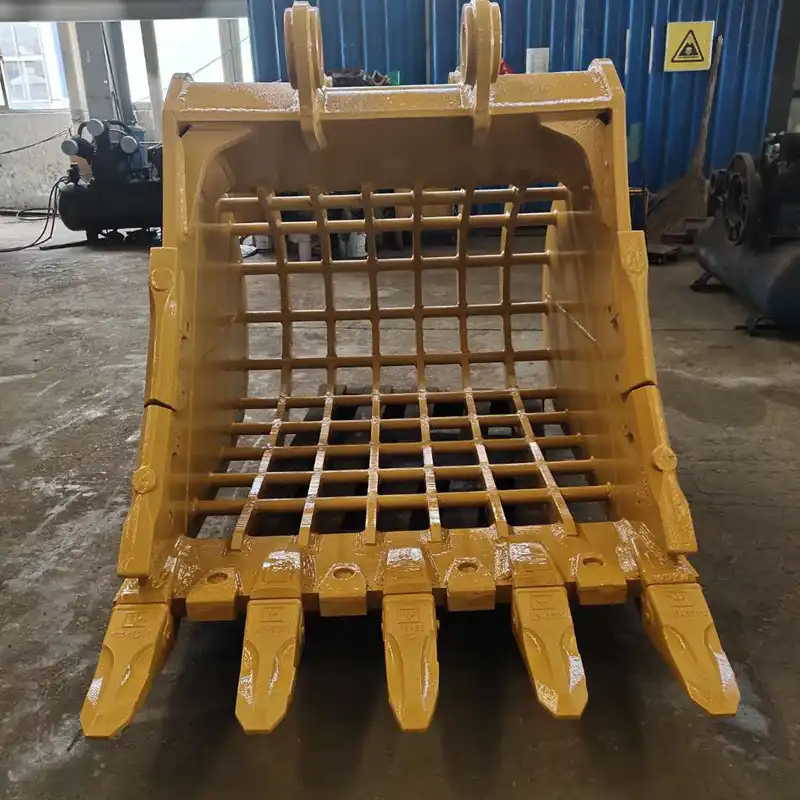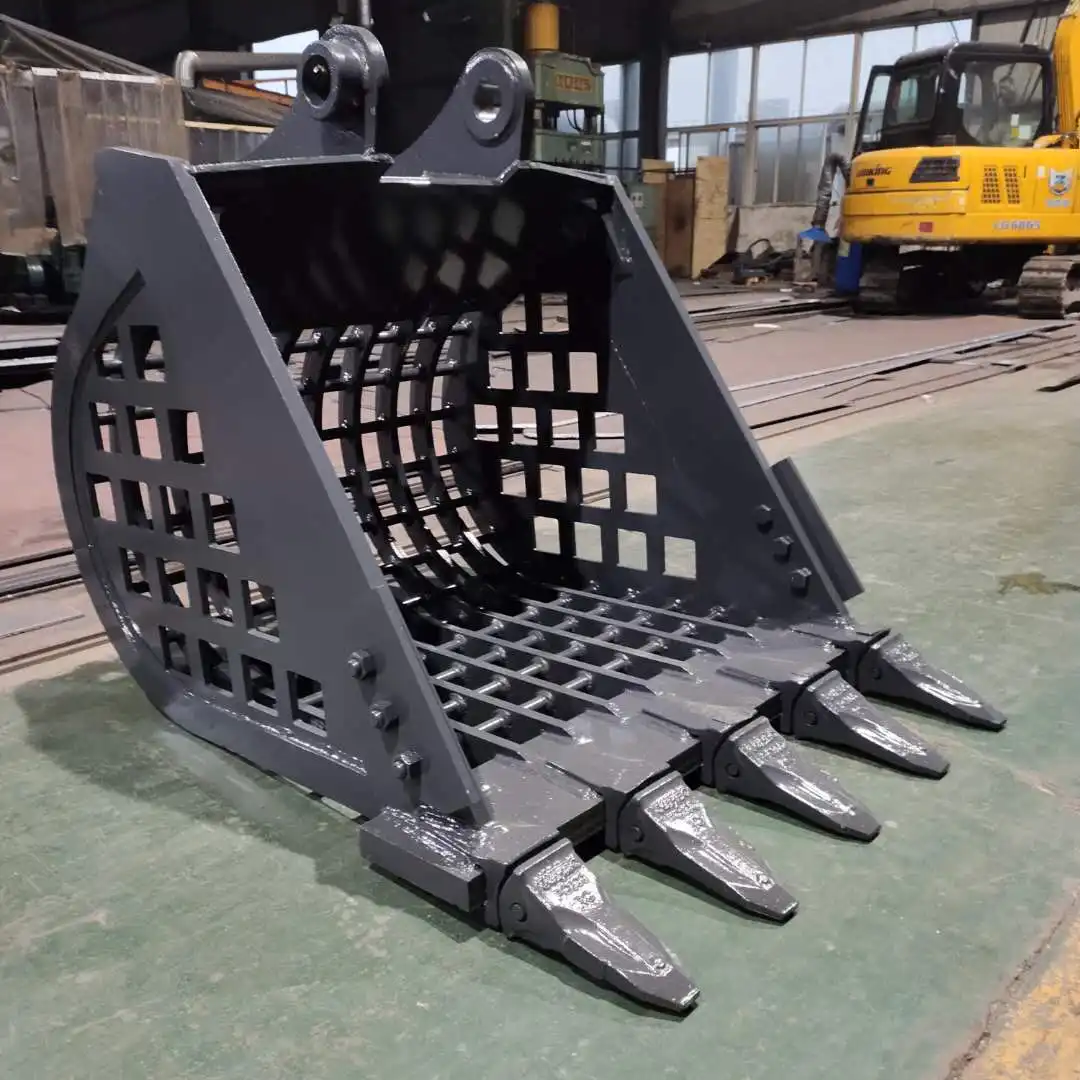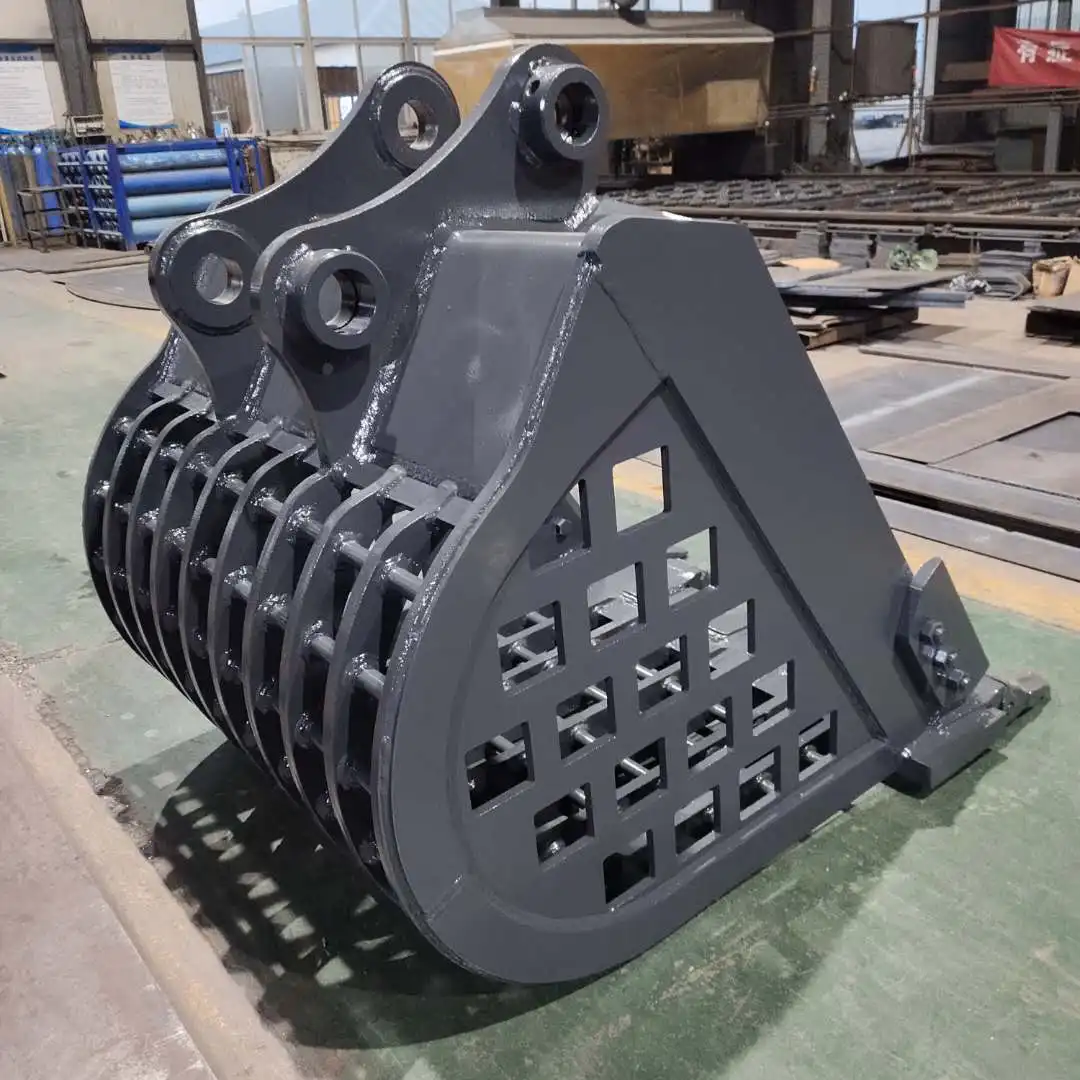Screening Bucket VS Crusher Bucket
When it comes to efficient material processing in construction, mining, and waste management, the choice between an excavator screening bucket and a crusher bucket can significantly impact your project's success. Both attachments offer unique advantages, but understanding their differences is crucial for making the right decision. Screening buckets excel at separating materials based on size, while crusher buckets break down larger pieces into smaller aggregates. This comparison will help you determine which attachment best suits your specific needs, ensuring optimal productivity and cost-effectiveness on your job site.
Comparing functionality: Screening vs. crushing processes
Separating materials: How screening buckets work
Excavator screening buckets are designed to efficiently separate materials based on size. They utilize a series of mesh screens or perforated plates that allow smaller particles to pass through while retaining larger ones. As the bucket rotates or vibrates, materials are sifted, resulting in sorted piles of different-sized aggregates.
The screening process is particularly effective for:
- Soil and compost preparation
- Separating rocks from soil
- Recycling construction and demolition waste
- Preparing landscaping materials
One of the key advantages of screening buckets is their ability to process materials on-site, reducing transportation costs and minimizing waste.
Breaking down materials: Crusher bucket operation
Crusher buckets, on the other hand, are designed to break down larger materials into smaller, more manageable pieces. They typically employ a jaw or impact crushing mechanism to reduce the size of rocks, concrete, or other hard materials.
Crusher buckets are particularly useful for:
- Reducing the size of demolition debris
- Processing quarry materials
- Recycling asphalt and concrete
- Creating aggregates for construction projects
The crushing process allows for on-site material reduction, which can significantly decrease transportation costs and increase the efficiency of material handling.
Versatility: Adaptability to different job requirements
Both screening and crusher buckets offer versatility in their applications, but they excel in different areas. Screening buckets are highly adaptable to various material types and can be used for both wet and dry materials. They're particularly useful in projects that require precise material separation or the removal of contaminants.
Crusher buckets, while less versatile in terms of material types, offer flexibility in producing different aggregate sizes by adjusting the crusher settings. This adaptability makes them valuable in projects where specific aggregate sizes are required or when dealing with varying hardness of materials.
The choice between a screening bucket and a crusher bucket often depends on the primary goal of your project. If material separation is the main objective, a screening bucket is likely the better choice. For projects focusing on size reduction and aggregate production, a crusher bucket would be more suitable.

Analyzing output quality: Fine materials vs. aggregate
Screening bucket output: Precision in material selection
Excavator screening buckets excel in producing precisely sorted materials. The output quality from a screening bucket is characterized by uniform size distribution within each sorted fraction. This precision is crucial for applications requiring specific material grades, such as in landscaping or road base preparation.
Key benefits of screening bucket output include:
- High-quality, consistently sized materials
- Efficient removal of unwanted elements (e.g., roots, debris)
- Ability to produce multiple grades of material in a single pass
- Minimal material waste due to accurate sorting
The precision of screening buckets makes them invaluable in projects where material purity and size consistency are paramount.
Crusher bucket results: Producing varied aggregate sizes
Crusher buckets generate a range of aggregate sizes, with the output depending on the crusher settings and the input material. While not as precise as screening buckets in terms of size uniformity, crusher buckets offer the advantage of reducing large materials into usable aggregates on-site.
Crusher bucket output characteristics include:
- Varied aggregate sizes within a specified range
- Ability to adjust output size by modifying crusher settings
- Efficient reduction of large materials into smaller, more manageable pieces
- Production of angular aggregates, which can be beneficial for certain construction applications
The versatility in aggregate production makes crusher buckets valuable for projects requiring on-site material processing and size reduction.
Impact on material reusability and recycling potential
Both screening and crusher buckets significantly enhance material reusability and recycling potential, but in different ways. Screening buckets improve recycling efficiency by separating materials into clean, uniform fractions. This separation allows for easier reuse or recycling of specific material types.
Crusher buckets, by reducing material size, make it easier to transport and reuse materials that might otherwise be discarded. For example, crushed concrete can be used as aggregate in new construction projects, reducing the need for virgin materials.
The choice between a screening bucket and a crusher bucket in terms of recycling potential often depends on the specific materials being processed and the intended use of the output. In many cases, using both types of buckets in sequence can maximize recycling efficiency and material value.

Assessing project suitability: When to use each
Ideal scenarios for screening bucket applications
Screening buckets shine in projects that require precise material separation or the removal of contaminants. They are particularly well-suited for:
- Topsoil preparation in landscaping projects
- Separating valuable materials from construction and demolition waste
- Processing compost and organic materials
- Cleaning and grading aggregates for road construction
- Separating materials in mining and quarrying operations
The efficiency of excavator screening buckets in these applications stems from their ability to quickly sort materials on-site, reducing transportation costs and improving overall project productivity.
Best use cases for crusher buckets in construction
Crusher buckets excel in scenarios where size reduction of hard materials is the primary goal. Ideal applications include:
- On-site recycling of concrete and asphalt in demolition projects
- Processing quarry materials for aggregate production
- Reducing the size of excavated rock in tunneling or mining operations
- Creating drainage materials from larger rocks
- Preparing materials for use in road base or backfill
The ability of crusher buckets to process materials on-site makes them invaluable in projects where transportation of large, heavy materials would be costly or impractical.
Combining buckets: Maximizing efficiency on job sites
In many cases, the most efficient approach is to use both screening and crusher buckets in tandem. This combination allows for comprehensive material processing, from size reduction to precise sorting. A typical workflow might involve:
- Using a crusher bucket to break down large materials
- Employing a screening bucket to sort the crushed material into specific size fractions
- Recirculating oversized materials back through the crusher bucket for further processing
This integrated approach maximizes material recovery, reduces waste, and ensures that output materials meet specific size and quality requirements. It's particularly effective in large-scale demolition and recycling projects where a variety of material types and sizes need to be processed.

FAQ
1. What is the main difference between a screening bucket and a crusher bucket?
A screening bucket separates materials based on size using mesh screens or perforated plates, while a crusher bucket breaks down larger materials into smaller pieces using a jaw or impact crushing mechanism.
2. Can screening buckets handle wet materials?
Yes, most screening buckets are designed to handle both wet and dry materials, making them versatile for various applications.
3. How do crusher buckets affect the shape of the output material?
Crusher buckets typically produce angular aggregates, which can be beneficial for certain construction applications where material interlocking is important.
4. Are screening buckets more environmentally friendly than crusher buckets?
Both types of buckets contribute to environmental sustainability by enabling on-site material processing and recycling. The choice depends on the specific project requirements and materials being processed.
5. Can I use a screening bucket and a crusher bucket together on the same project?
Absolutely. Using both types of buckets in combination can maximize efficiency, allowing for comprehensive material processing from size reduction to precise sorting.
China Excavator Screening Bucket Supplier
Choosing between a screening bucket and a crusher bucket depends on your project's specific needs. Screening buckets excel in material separation and producing uniform size distributions, making them ideal for landscaping, waste management, and projects requiring precise material grades. Crusher buckets, on the other hand, are best suited for size reduction and on-site recycling of hard materials like concrete and rock. For maximum efficiency, consider using both types in tandem to create a comprehensive material processing solution. By understanding the strengths of each attachment, you can optimize your equipment choices, reduce costs, and improve project outcomes.
TianNuo Machinery stands out as a leading excavator screening bucket supplier in China. Their product line includes a wide range of attachments for various industries, including railway maintenance equipment, excavator modification equipment, and engineering arms. TianNuo's screening bucket boasts impressive specifications, including a customizable bucket capacity of 0.4 m³ and grid specifications of 55 x 55 mm. Crafted from high-quality Q460 + WH60C materials, these buckets are specifically designed for railway ballast screening operations. For more information about TianNuo's products, contact us at boom@stnd-machinery.com.
References
- TianNuo Machinery Official Website
- Construction Equipment Magazine
- Excavator Attachment Industry Report 2023
- Journal of Construction Engineering and Management
- Waste Management & Research
About Author: Arm
Arm is a leading expert in the field of specialized construction and railway maintenance equipment, working at Tiannuo Company. Tiannuo specializes in manufacturing a wide range of products, including railway maintenance equipment like railway sleeper changing machines and screening machines, excavator modification equipment such as excavator lifting cabs, various engineering arms for excavators, excavator accessories like digging buckets, and engineering vehicle auxiliary equipment like loader buckets.

